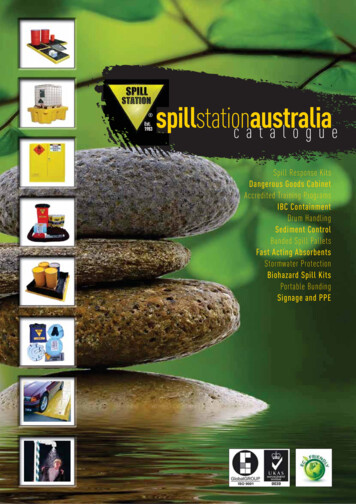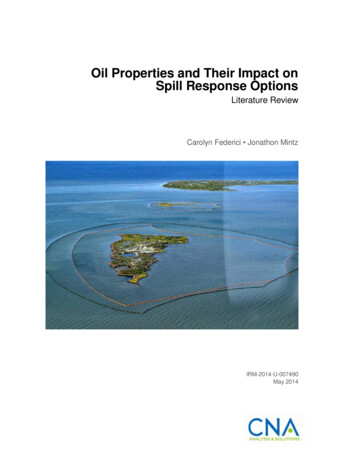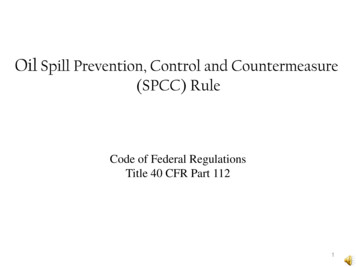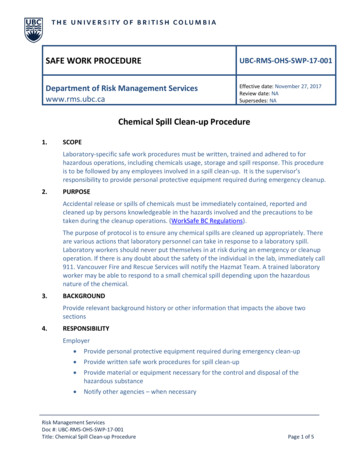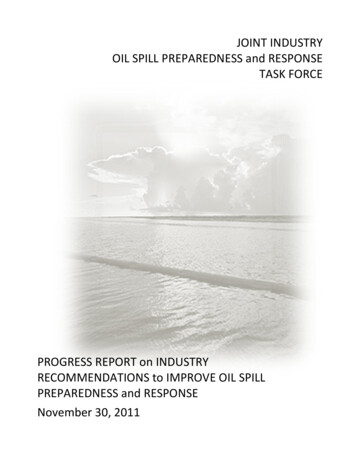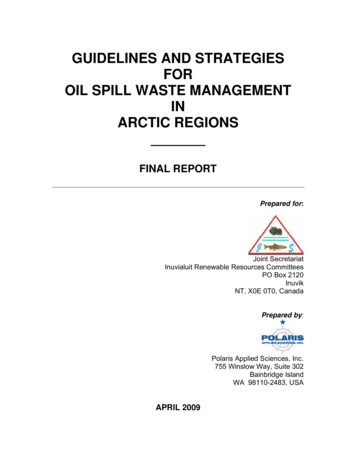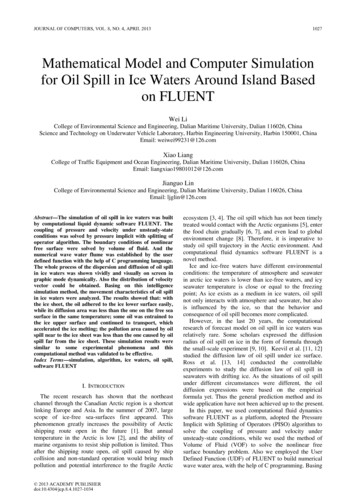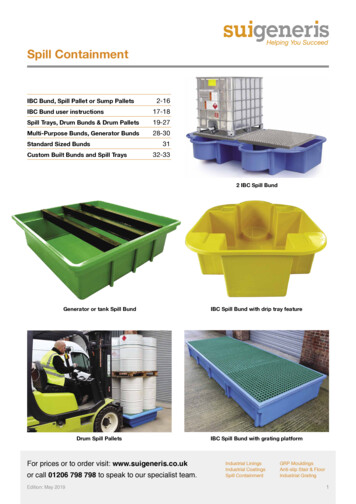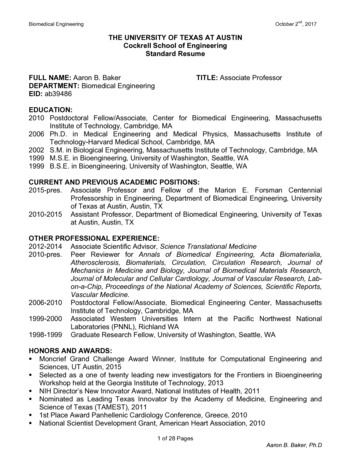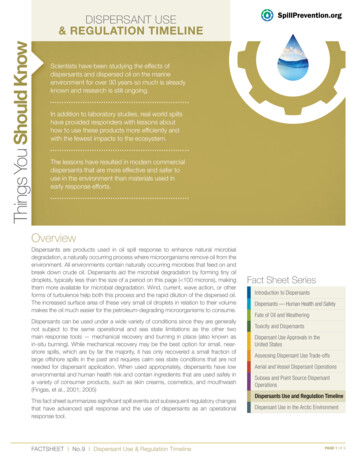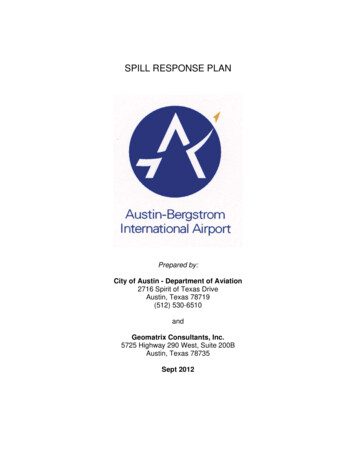
Transcription
SPILL RESPONSE PLANPrepared by:City of Austin - Department of Aviation2716 Spirit of Texas DriveAustin, Texas 78719(512) 530-6510andGeomatrix Consultants, Inc.5725 Highway 290 West, Suite 200BAustin, Texas 78735Sept 2012
Table of ContentsTABLE OF CONTENTS1.0INTRODUCTION . F-12.0 FACILITY OPERATIONS AND SPILL CHARACTERISTICS. F-22.1 SPILL CATEGORIES . F-32.2 REPORTABLE QUANTITIES . F-32.3 REPORTABLE QUANTITIES FOR COMMON ABIA CHEMICALS . F-33.0 SPILL RESPONDER ROLES AND RESPONSIBILITIES . F-63.1 ABIA EXECUTIVE DIRECTOR . F-63.2 DIRECTOR OF FACILITIES AND OPERATIONS . F-63.3 DOA ENVIRONMENTAL COORDINATOR (PLANNING AND ENGINEERING) . F-63.4 PUBLIC SAFETY SERVICES . F-73.4.1 Public Safety-Aircraft Rescue and Fire Fighting (ARFF). F-73.4.2 Public Safety-Airport Police . F-73.4.3 Operations Division . F-83.5 FIELD MAINTENANCE . F-83.6 BUILDING MAINTENANCE . F-93.7 PUBLIC INFORMATION . F-93.8 AIRPORT FINANCE . F-93.9 RESPONSIBLE TENANT . F-93.10 AIRORT COMMUNICATIONS DISPATCH . F-104.0 SPILL RESPONSE PROCEDURES . F-114.1 PROCEDURE 1 - ALL MAJOR SPILLS AT ABIA. F-114.2 PROCEDURE 2- ALL MINOR SPILLS AT ABIA . F-115.0 NOTIFICATION SEQUENCE. F-125.1 REPORTABLE QUANTITY NOTIFICATION REQUIREMENTS . F-125.2 NOTIFICATION REQUIREMENTS FOR MINOR SPILLS AT . F-136.0 TRAINING . F-146.1 SPILL RESPONDER TRAINING . F-146.1.1 Training in Spill Recognition and Reporting . F-146.1.2 Training in Basic Spill Countermeasures . F-146.1.3 Training in Advanced Spill Response . F-146.2 SPILL RESPONSE PLAN TRAINING . F-147.0SPILL RESPONSE EQUIPMENT AND MATERIALS. F-168.0SAFETY . F-179.0 WASTE DISPOSAL AND SITE RESTORATION. F-189.1 WASTE DISPOSAL . F-189.2 SITE RESTORATION . F-1810.0 POST-CLEANUP ASSESSMENTS . F-1910.1 FOLLOW UP INSPECTIONS . F-1910.2 ENVIRONMENTAL INVESTIGATIONS . F-1911.0 REPORTING AND RECORD KEEPING . F-2011.1 SPILL INCIDENT REPORTS. F-20i
Table of Contents11.2 GOVERNMENTAL REPORTING . F-2011.3 RECORD KEEPING . F-2112.0 PLAN REVISIONS . F-22FIGURESFigure 2-1ABIA Operational AreasAPPENDICESAppendix AAppendix BAppendix CAppendix DSpill Response ProceduresSpill Response Plan Notification ListReportable QuantitiesAustin-Bergstrom International Airport Spill Incident Report (Form 10-1)ii
Section 1Introduction1.0Austin-Bergstrom International AirportSpill Response PlanSept 2012IntroductionThis Spill Response Plan (SRP) has been prepared by the City of Austin (DOA) Departmentof Aviation (DOA). The SRP specifies emergency and non-emergency response proceduresto be used during spill events at the Austin-Bergstrom International Airport (ABIA).Operations at ABIA involve the use, storage, and handling of many different chemicals and,despite the continual efforts of ABIA operators to prevent them, spills do periodically occur.The protocol and procedures required by this SRP are designed to ensure ABIA maintains astate of readiness and is capable of responding to spills in an expeditious and orderlymanner that maximizes protection of the Spill Responders, the general public, and theenvironment.Spills represent a significant liability. At a minimum, responding to spills can be extremelycostly and disruptive to ABIA operations. Worse yet, spills can represent a serious threat tohuman health or the environment. All appropriate Tenant personnel at ABIA mustunderstand the adverse impact caused by spills and must incorporate preventative measuresas an integral part of their day-to-day operations. The COA reserves the right to recover allcosts associated with spill response and cleanup operations resulting from ABIA Tenantspills.F-1
Section 2Facility Operations and Spill Characteristics2.0Austin-Bergstrom International AirportSpill Response PlanSept 2012Facility Operations and Spill CharacteristicsOperations at ABIA involve the DOA and over 50 different Tenants who perform a variety ofindustrial activities such as: servicing, repairing, and maintaining aircraft and ground service vehicles; cleaning, painting, repairing, and fueling equipment; and handling and storing de-/anti-icing agents.From an operational perspective, the industrial activities at ABIA are divided into two distinct“Operations” areas: Airside Operations and Landside Operations. Airside refers to all areaswhere aircraft are operated or serviced. Landside refers to all other areas. These areas aredelineated on Figure 2-1.Operations at ABIA involve the use of a wide variety of chemicals including vehicle and jetfuels, solvents, paints, cleaners, greases, oils, “blue juice” and others. Based on historicalspill records, the activities undertaken at ABIA that most frequently result in a spill arefueling/de-fueling of aircraft and ground support equipment, and lavatory service operations.The ABIA areas where these operations typically take place are the Passenger Terminal, AirCargo, Texas Army Air National Guard (TANG), State Aircraft Pooling Board (SAPB), andthe General Aviation Aprons, and Ground Service Equipment (GSE) Maintenance Area, asillustrated in Figure 2-2.Fuel spills typically occur as a result of one or more of the following: Valves designed to prevent overfilling of aircraft reservoirs malfunction; Fuel dispenser hoses malfunction or become damaged; The integrity of the truck-mounted tank walls or fittings fail; Automated shut-off systems on fuel tanks fail; Techniques utilized to transfer fuel from aboveground to truck-mounted tanks areimproper; or Above ground storage tanks leak.Lavatory liquids (i.e. blue juice) spills typically occur as a result of one or more of thefollowing: Lavatory dispenser hoses and fittings malfunction; Techniques utilized to transfer lavatory wastes from aircraft to truck-mounted tanksand from the truck-mounted tanks to the triturator are improper; or The facility’s triturator malfunctions.Other reasons chemical spills may occur at ABIA include human error in handling chemicals,leakage from air cargo containers carrying hazardous materials, and vehicular accidents.Figure 2-2 identifies the areas where spills have most frequently occurred based on historicalrecords.F-2
Section 2Facility Operations and Spill Characteristics2.1Austin-Bergstrom International AirportSpill Response PlanSept 2012SPILL CATEGORIESFor purposes of implementing certain response and notification protocols specified in thisSRP, two distinct categories of spills have been identified: Major Spills and Minor Spills. Spillresponse and notification protocols will differ depending on the category of a given spill.Definitions for these spill categories are provided below.Major Spills are those that meet ANY of the following criteria: The spilled material is considered a health or physical hazard based on its chemicalor physical properties and the quantity of spilled material exceeds 3 gallons or aReportable Quantity (RQ) as defined under Title 30 of the Texas Administrative CodeChapter 327.4, whichever is less; The spilled material has entered the storm water drainage system or such entry isimminent; The spilled material has the potential to migrate off property; The chemical and physical properties of the spilled material are unknown, or the typeof material is unknown; The spilled material adversely affects the environment; or, The spilled material cannot be controlled or contained by the responsible Tenant.Minor Spills are those that do not meet ANY of the above criteria.2.2REPORTABLE QUANTITIESUnderstanding the term “Reportable Quantity” (RQ) is important to the proper implementationof this SRP as it has a direct bearing on spill notification and reporting requirements. RQ isthe term that is used by the US Environmental Protection Agency (EPA) and the TexasCommission on Environmental Quality (TCEQ) to define pre-set measures of chemicalswhich, if spilled in excess of, trigger special notification and reporting requirements. RQsdiffer depending on the specific chemical or product type, and depending on the whether therelease is to land or to water. For purposes of this SRP, the chemicals or product types forwhich RQs are provided are described as follows: Hazardous substances –chemicals specified by the EPA under Code of FederalRegulations (CFR) 40 Part 302 and the TCEQ under Texas Administrative Code(TAC) Chapter 327. The chemicals are listed due to their toxicity. Petroleum products- petroleum substances derived from distillation and processing ofcrude oil, including vehicle and aircraft fuels such as diesel, gasoline, and JP-4. Thiscategory, however, does not apply to Naphtha-type or kerosene-type jet fuels such asthose used at ABIA. Oils – crude oil and any other oils that do not meet the definition of a petroleumproduct. Naphtha-type and kerosene-type jet fuels are considered oils for RQpurposes. Industrial Solid Wastes or other substances – materials defined by the TCEQ assolid wastes resulting from or incidental to any process of industry or manufacturing,mining, or agricultural operations.F-3
Section 2Facility Operations and Spill CharacteristicsAustin-Bergstrom International AirportSpill Response PlanSept 2012The RQs specified under each are presented in the following sections. Hazardous SubstancesFor releases to land, hazardous substance RQs are listed in a Table inChapter 327 of the Texas Administrative Code. A copy of this table is providedin Appendix C for reference.For releases to state waters, the RQ for a hazardous substance is whicheveris less: 100 pounds, or the RQ listed in 327.4. By example, the RQ listed in327.4 for toluene is 1000 pounds (140 gallons). If released to waters of thestate, however, the RQ is 100 pounds (14 gallons). OilsFor releases to land, the RQ is 210 gallons (five barrels)For releases to waters in the state, the RQ is the quantity sufficient to create avisible sheen on the surface of the water. Petroleum Products (and Used Oils)For releases to land, the RQ is 25 gallons unless the releasing facility meetscertain exemptions under petroleum storage tank regulations, in which casethe RQ is 210 gallons.For releases to water, the RQ is the quantity sufficient to create a visiblesheen on the surface of the water. 2.3Industrial Solid Waste and Other SubstancesThere is no RQ for releases to land.For releases to waters in the state the RQ is 100 pounds.REPORTABLE QUANTITIES FOR COMMON ABIA CHEMICALSTo facilitate RQ evaluations specific to operations at ABIA, a list of the chemicals mostfrequently used during operations at ABIA, and their associated RQs, is provided below. If aspill of any of these, or other, chemicals occurs, and the amount spilled is in excess of themeasure cited, then a RQ spill has occurred and appropriate notification and reportingprocedures must be implemented, as discussed in later sections.Since the RQ is often listed in pounds and spills are typically the result of a release of a liquidvolume, it is necessary to convert from gallons to pounds to determine compliancerequirements for many spills. The Texas Department of Health has a “Gallons To PoundsConverter” that will make this conversion for any substance given the specific gravity of thesubstance, as listed on the Material Safety Data Sheet (MSDS). This converter is found /WeightCalc2.htm.Sample conversions are listed in the following Table for several of the common-usechemicals at ABIA.F-4
Section 2Facility Operations and Spill CharacteristicsChemical UsedChemical TypeAustin-Bergstrom International AirportSpill Response PlanSept 2012Vehicle GasolineNew OilsUsed OilsJet-A Jet FuelGlutaraldehyde (Blue Juice)Propylene Glycol (Deicing)Ethylene Glycol (Deicing)Petroleum ProductOilUsed OilOilHazardous SubstanceHazardous SubstanceHazardous SubstanceToilet Detergent/DeodorantIndustrial substanceRQ for Releaseto Land25 gallons210 gallons25 gallons210 gallonsNot ApplicableNot Applicable5000 pounds(550 gal)Not ApplicableDieselHydraulic fluidsPetroleum ProductOil25 gallons210 gallonsF-5RQ for Release toWaterCreate SheenCreate SheenCreate SheenCreate Sheen100 pounds (11 gal)100 pounds (12 gal)100 pounds(10 gal)100 pounds (needSpecific Gravity of theproduct mixture tocalculate gal.)Create SheenCreate Sheen
Section 3Spill Responder Roles and Responsibilities3.0Austin-Bergstrom International AirportSpill Response PlanSept 2012Spill Responder Roles and ResponsibilitiesTo maintain a state of readiness, certain ABIA personnel and Divisions have been delegatedthe appropriate authorities and assigned duties and responsibilities to ensure spill events atABIA are handled properly. During a spill response event, the “Spill Responders” workcollectively as a Team with a common goal of accomplishing spill containment and clean upsexpeditiously and in a manner that ensures the safety and protection of the Spill Responders,the general public, and the environment.The individuals and Divisions that have direct or indirect spill response duties at ABIA, andtheir specific responsibilities, are described below:3.1ABIA EXECUTIVE DIRECTORThe ABIA Execute Director is responsible for ensuring ABIA institutes those policies requiredto ensure all necessary spill response labor and equipment resources are available toproperly respond to spill events. The ABIA Executive Director is not required to be on-siteduring spill response.3.2DIRECTOR OF FACILITIES AND OPERATIONSThe Director of Facilities and Operations is responsible for ensuring a prompt and orderlyresponse to all spills and for continuously maintaining a state of readiness on the part of theSpill Responders. The Director is not required to be on–site during spill responses.3.3DOA ENVIRONMENTAL COORDINATOR (PLANNING AND ENGINEERING)The DOA Environmental Coordinator (EC) has responsibilities for spills that occur at theairport. To the extent practicable, the EC will respond on-site during responses to all Majorspills. The EC is not required to respond on-site to minor spills. Depending on the nature ofthe spill, the EC will have the following responsibilities: Make notifications to appropriate regulatory and governmental agencies based onspill event conditions and in accordance with Spill Notification Sequence criteria (seeSection 5.0). Make notification to DOA Public Information Office in accordance with SpillNotification Sequence criteria (see Section 5.0). Provide technical assistance as necessary to minimize environmental impacts due tospill response operations and/or procedures. Provide operational information pertaining to the storm water drainage system andassist with restoration efforts. Prepare written reports for ABIA Tenants, EPA, State, and Local agencies. Develop and implement environmental procedures and protocols to ensurecompliance with local, state, and federal regulations. Conduct facility inspections and follow-up spill response investigations to ensureproper remediation. Initiate post-cleanup environmental sampling and confirm proper waste disposal. Maintain a spill response database.F-6
Section 3Spill Responder Roles and Responsibilities Austin-Bergstrom International AirportSpill Response PlanSept 2012Review Inventory of Spill Response Kit supplies, prepared by Field Maintenance. Record costs incurred Procure and store DOA spill response materials and replenish supplies.3.4 PUBLIC SAFETY SERVICESPublic Safety Services comprise the Operations and Aircraft Rescue and Fire Fighting(ARFF) Divisions, and the Airport Police. The roles and responsibilities for each aredescribed below.3.4.1Public Safety-Aircraft Rescue and Fire Fighting (ARFF)ARFF is a division of the Austin Fire Department (AFD) and is stationed at ABIA for theprimary purpose of responding in the event of an aircraft accident. As a secondary role,ARFF provides on-site spill response for all Major and Minor chemical spills that occur inAirside Operations areas. ARFF does not respond to chemical spills that occur in LandsideOperations areas. Depending on the nature of the spill, ARFF’s Spill Response duties willinclude the following: Assist Operations with initial spill assessment. Assist Operations in directing and coordinating Spill Responders in all spillcontainment and clean-up activities. As deemed necessary, notify the Austin FireDepartment (AFD) HazMat Team for additional assistance. To the extent possible, ensure spill does not enter storm drain system or migrate offairport property. Transport recovered spill materials and response-derived wastes to FieldMaintenance storage area when a responsible party is not identified. Ensure all transportation, storage, and disposal of spilled materials and spill responsematerials (e.g., spent absorbent materials) are undertaken in accordance withapplicable city, state, and federal regulations for all spills at non-Tenant facilities.(The responsible Tenant shall coordinate all transportation, storage, and disposalactivities for chemical spills at Tenant facilities). Assist Tenants and DOA facilities with follow-up reporting and response proceduresas necessary.3.4.2Public Safety-Airport PoliceProperly trained Airport Police personnel will provide on-site support as needed during allchemical spills at ABIA. Depending on the nature of the spill event, Airport Police duties willinclude: Secure the spill site; Control vehicle and pedestrian traffic; Initiate crowd control measures; and Implement evacuation procedures.F-7
Section 3Spill Responder Roles and Responsibilities3.4.3Austin-Bergstrom International AirportSpill Response PlanSept 2012Operations DivisionProperly trained personnel from Operations Division will take the lead in spill response for allspill containment and cleanup activities. Operations will be supported as necessary by ARFFand/or AFD HazMat. Depending on the nature of the spill event, Operations duties willinclude: Direct and coordinate Spill Responders in all spill containment and cleanup activities. Close affected areas and issue appropriate NOTAMS. Close all gates and valves at affected drainage system(s) to prevent the spilledmaterials from entering the drainage system. Assist DOA Public Safety with securing the site and redirecting vehicle traffic. Assist DOA Public Safety with evacuation and crowd control efforts. Ensure responsible party is using proper spill response techniques, including theproper disposal of spilled materials and impacted media (this applies to Tenant spillsonly). Complete ABIA Spill Incident Report and forward a copy to the DOA EnvironmentalCoordinator within 24 hours. Assist the Environmental Coordinator with follow-up inspections. Monitor and enforce Tenant compliance with DOA Spill Response requirements. Inventory DOA Spill Response Kits and issue Work Orders to Field Maintenance toreplace used materials.3.5FIELD MAINTENANCEProperly trained personnel from Field Maintenance will provide on-site spill responseassistance during spill events. Depending on the nature of the spill event, FieldMaintenance’s duties will include: Close all gates and valves at affected drainage system(s) to prevent the spilledmaterials from entering the drainage system; If no gates or valves are available, block the flow of hazardous materials to permit itscapture and removal using absorbents or other materials; Should Water Quality Pond E or N contain a significant amount of hazardousmaterials such as petroleum products, commence material extraction and arrange tohave the contaminated materials removed from the site; If a Responsible Party has been identified, provide assistance the Responsible Party,as necessary; Assist with restoration efforts to return site to its pre-spill condition; Support Environmental Coordinator in the performance of sampling.F-8
Section 3Spill Responder Roles and ResponsibilitiesAustin-Bergstrom International AirportSpill Response PlanSept 2012Note: DOA spill response materials are supplied in Spill Response Kits. These SpillResponse Kits are intended to supplement Tenant Spill Response Kits and are NOT meantto replace them.3.6BUILDING MAINTENANCEPersonnel from Building Maintenance will not typically be directly involved in the initial spillresponse activities. Depending on the nature of the spill event, Building Maintenance’sduties will include: Support the Environmental Coordinator with post-cleanup environmental sampling; Assist with restoration efforts to return the spill site to its pre-spill condition; Assist with follow-up inspections.3.7PUBLIC INFORMATIONPersonnel from the ABIA Public Information Office do not have responsibilities to provide onsite support during spill response events. Depending on the nature of the spill event, the PIOrepresentative will: 3.8Advise and update the public concerning the status of spills through the issuance ofpress releases or via other appropriate media.AIRPORT FINANCEPersonnel from the ABIA Airport Finance do not have responsibilities to provide on-sitesupport during spill response events. Airport Finance will: Assist with the procurement of spill response supplies for the DOA; Assist with cost tracking and recovery during spill response events.3.9RESPONSIBLE TENANTThe Tenant responsible for a chemical spill is required to provide on-site spill responsesupport. Each ABIA Tenant is required to have a Spill Response Contractor availableto respond to Major Spills and is expected to conduct all containment and clean-up ofMinor Spills at the Tenants facility. Depending on the nature of the spill, the ResponsibleTenant’s duties will include: Undertake the necessary measures to control, contain, and cleanup the spilledmaterials; Use proper disposal techniques; Restore the site to pre-spill conditions; Complete ABIA Spill Incident report and maintain the report in an on-site file; and Assist with follow up inspections.F-9
Section 5Notification Sequence3.10Austin-Bergstrom International AirportSpill Response PlanSept 2012AIRPORT COMMUNICATIONS DISPATCHAirport Communications Dispatch is the first point of contact in the Notification Sequence(see Section 5.0). Airport Communications Dispatch then contacts ARFF or AFD andOperations according to the Notification Sequence.F-10
Section 5Notification Sequence4.0Austin-Bergstrom International AirportSpill Response PlanSept 2012Spill Response ProceduresThere are three primary components that are common to all spill responses, described asfollows: Counter Measures - immediate actions taken to eliminate the source or cause of thespill; and/or to stop or slow the spread or migration of spilled materials; Clean Up - controlled and coordinated actions taken to contain and remove spilledmaterials and any impacted media, such as soils, sediments, concrete, and/orasphalt; Restoration – Post-cleanup actions taken to return the site to its pre-spill condition,including replacement of impacted soil, power washing of paved surfaces, sampling,revegetation, and removal of debris.Regardless of the location or the nature of a chemical spill at ABIA, the objective of the spillresponse will always be the same:To accomplish spill containment and clean up in an expeditious and orderly manner thatmaximizes the protection of all Spill Responders, the general public, and the environment.Although all spill response operations share this common goal, the specific procedures thatwill be used, and the Spill Responders that will be involved, will be different depending on thespill classification. From a response perspective, the two main response categories are:Procedure 1 - Responses for all major spills at ABIA.Procedure 2 - Responses for all minor spills at ABIA.Spill response procedures for each of these are described in the following sections.4.1PROCEDURE 1 - ALL MAJOR SPILLS AT ABIAFlow Chart 1 illustrates Spill Response Procedures for all major chemical spills that occur atABIA. A detailed description for Procedure 1 of the Spill Response procedures is presentedin Appendix A.4.2PROCEDURE 2- ALL MINOR SPILLS AT ABIAFlow Chart 2 illustrates Spill Response Procedures for all minor spills at ABIA. A detaileddescription for Procedure 2 is presented in Appendix A.F-11
Section 5Notification Sequence5.0Austin-Bergstrom International AirportSpill Response PlanSept 2012Notification SequenceThe Notification Sequence must be performed for all major spills. The Notification Sequenceis illustrated in Flowchart 3 and described below.The Notification Sequence is initiated by the individual who first observes the spill (i.e. theFirst Observer). The First Observer calls Airport Communications Dispatch at 530–2242(ABIA) and provides the following information:(1) Name, address, and telephone number of party responsible for the spill;(2) Date, time, and location of the spill;(3) Source of the spill;(4) Type of material spilled;(5) Quantity spilled;(6) Actions taken to contain and respond to the spill; and(7) Whether the spill entered the storm water drainage system.After notifying the Airport Communications Dispatch, the First Observer notifies his/herSupervisor.Upon receiving notice, the Airport Communications Dispatch notifies Spill Responders, asfollows:For Airside Spills: ARFF at 911 for emergencies and 411 for non-emergencies, and Operations Coordinator at 530-7550 or 845-7336 (cell).For Landside Spills AFD Hazmat at 911 for Emergencies and 411 for non-emergencies, and Operations Coordinator at 530-7550 or 845-7336 (cell).After completing an assessment of the spill, Operations will make notifications to: Field Maintenance at (512) 530-6352 ; Building Maintenance at (530-7504), and DOA EC at (530-6621 or 748-3263) as appropriate.5.1Reportable Quantity Notification RequirementsIn addition to the Spill Responder notifications described above, depending on the specificspill conditions, certain outside governmental agencies, and ABIA’s Public Information Office,may also require notification. The DOA EC, or his designee, will be responsible for thesenotifications. The criteria to be used by the EC or designee are as follows: If the spill is over 25 gallons or enters ABIA’s storm water system, but under the RQ(see Section 2.2), the EC, or his designee, will notify the following City of AustinDepartment:- Watershed Protection and Development Review(512) 974-2550If the spill is equal to or greater than the RQ for the spilled material, the DOA EC, orhis designee, will provide verbal notification to the following agencies within 24 hours:
This Spill Response Plan (SRP) has been prepared by the City of Austin (DOA) Department of Aviation (DOA). The SRP specifies emergency and non-emergency response procedures to be used during spill events at the Austin-Bergstrom International Airport (ABIA). Operations at ABIA involve the use, storage, and handling of many different chemicals and,
